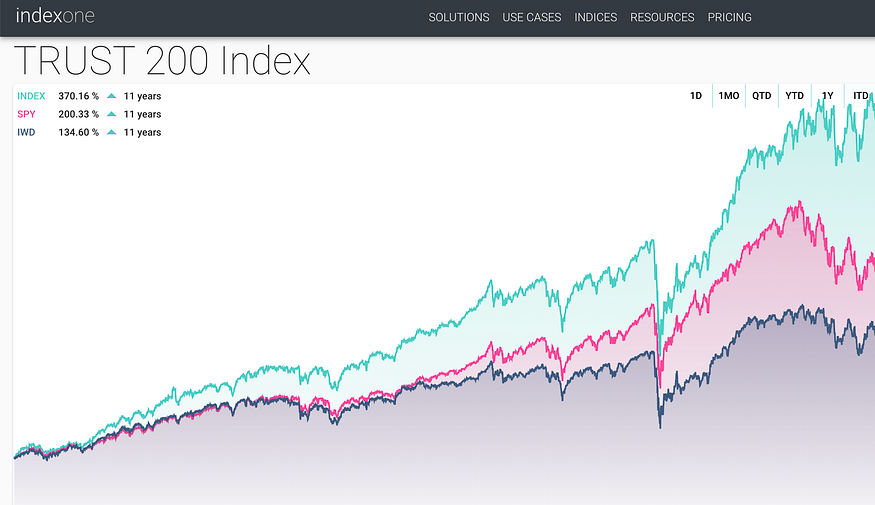Trust Challenges & Predictions 2023
The business case for trust is indisputable. As the chart below shows, for the past eleven years our Trust 200 Index, a diversified mix of the most trustworthy public companies has handsomely rewarded those who chose trust as a strategic imperative. This includes business leaders and their stakeholders, and also investors. Yet we seem to be stuck in a trust-free fall across most societal institutions. Why is that?

It’s certainly not due to a lack of interest in the subject of trust nor a shortage of those attempting to monetize trust. In fact, 2022 may have been a banner year for new trust initiatives. Many of the large advisory firms have boarded the trust train, yet their initiatives continue to skirt the two key challenges of trust building. What are they?
The Leadership Challenge
Trust is not a soft skill: Most leaders remain risk-focused never considering trust until a crisis. Do you know why?
- They have never thought about the role trust plays in organizational success.
- They have been taught to always defer to legal and compliance, who have no trust or other mistakenly termed “soft skill” expertise.
- They would rather not think about the long-term reputation costs associated with a crisis until they are faced with one.
Leaders must own trust: Until leaders are encouraged to acknowledge that the trust “buck” stops on their desk, any and every trust workaround initiative will fail over time. In the short term, these programs may provide some good publicity opportunities but they are not sustainable.
Trust requires cleaning your own house first: In every organization, trust is built from the inside out, over time, and in incremental steps, and it must always begin with trustworthy leaders. “Talking” trust and acting on it are not the same. In fact, when a leader is seen talking about trust, think about whether his/her everyday actions match their words. In almost every case they do not.
The fix: It begins with leadership acknowledgment of trust as an organizational imperative, an enormous hurdle, followed by identification of the internal behaviors that are weakening trust, and finally by the willingness to allocate resources to mend the behavioral breaks.
The Language Challenge
Two very different and distinct trust languages: Those selling short-term trust “solutions” continue to conflate the perception of trust with trust. What’s the difference?
Trust: An “inside out” long-term strategic mindset. Trust is the outcome of principled behavior. Advising on trust is the job of those with interpersonal trust expertise including some in the leadership, ethics, and culture change professions. It is not fast or easy. Leaders remain risk focused or believe that trust is a soft skill. Long-term internal trust initiatives are happening, but they are not the ones the public tends to hear about. If done properly they are sustainable and provide a strategic advantage.
Perception of trust: An “outside-in” program/activity. Essentially the job of the PR, reputation, branding, and customer service industries work alongside internal communications (not leadership). These initiatives often begin with a survey performed by the organization selling the next “trust solution.” These perceptions of trust programs are fast, short-term, and provide a relatively easy deflection from internal trust building. Some recent examples include data privacy trust, AI trust, DE&I trust, wellness trust, ESG rating trust, brand trust, customer trust, and leaders' “taking a stand” trust. A new perception of trust products certainly has a place, especially for those who are successfully selling them and those on the speaking circuit, but until a clear distinction and universal adoption occur, the language of trust will remain conflated, and little progress will be made in reversing the breakdown in societal trust.
The fix: It begins with leadership buy-in and commitment, followed by an analysis of the behaviors weakening internal trust, and the adoption of a common trust language that meets the needs of all stakeholders. In business, that means starting with employees (not customers) and working outward.
The Prediction for 2023
The breakdown in trust will continue well into 2023 and beyond unless we begin to address both the leadership and language challenges of trust. Notice that the solutions to both are very similar. This is also not an accident. Trust is built by trustworthy leaders who have embraced trust as a strategic imperative. Everything else is no more than a perception of trust.
More By This Author:
Trustworthy Companies Offer Superior Investment Returns With Less RiskMost Trustworthy Public Companies
Take these Actions to Further Weaken Stakeholder Trust



